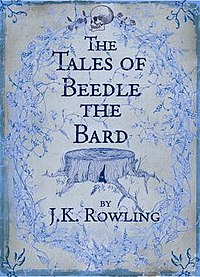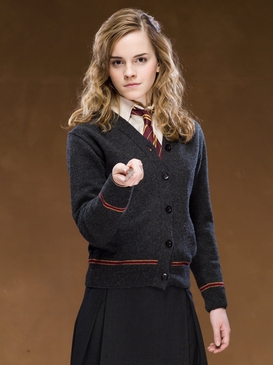
Hermione Jean Granger is a fictional character in J. K. Rowling's Harry Potter series. She first appears in the novel Harry Potter and the Philosopher's Stone (1997), on the Hogwarts express as a first year student on her way to Hogwarts. After Harry and Ron save her from a mountain troll in the girls' restroom, she becomes best friends with them and often uses her quick wit, deft recall, and encyclopaedic knowledge to lend aid in dire situations. Rowling has stated that Hermione resembles herself as a young girl, with her insecurity and fear of failure.

Lord Voldemort is a character and the main antagonist in J. K. Rowling's series of Harry Potter novels. The character first appeared in Harry Potter and the Philosopher's Stone, which was published in 1997, and returned either in person or in flashbacks in each book and its film adaptation in the series except the third, Harry Potter and the Prisoner of Azkaban, in which he is only mentioned.

Prof. Albus Percival Wulfric Brian Dumbledore is a fictional character in J. K. Rowling's Harry Potter series. For most of the series, he is the headmaster of the wizarding school Hogwarts. As part of his backstory, it is revealed that he is the founder and leader of the Order of the Phoenix, an organisation dedicated to fighting Lord Voldemort, the main antagonist of the series.

The Order of the Phoenix is a secret organisation in the Harry Potter series of fiction books written by J. K. Rowling. Founded by Albus Dumbledore to fight Lord Voldemort and his followers, the Death Eaters, the Order lends its name to the fifth book of the series, Harry Potter and the Order of the Phoenix. The original members of the Order of the Phoenix include Sirius Black, Emmeline Vance, Nymphadora Tonks, Benjy Fenwick, Kingsley Shacklebolt, Edgar Bones, Lily Potter, James Potter, Sturgis Podmore, Caradoc Dearborn, Bill Weasley, Charlie Weasley, Fleur Delacour, Alice Longbottom, Frank Longbottom, Dorcas Meadowes, Albus Dumbledore, Hestia Jones, Remus Lupin, Severus Snape, Aberforth Dumbledore, Dedalus Diggle, Minerva McGonagall and Marlene McKinnon.

The Ministry of Magic is the government of the Magical community of Britain in J. K. Rowling's Wizarding World, headed by an official entitled the Minister for Magic. The magical government in Britain is first mentioned in Harry Potter and the Philosopher's Stone; the Ministry makes its first proper appearance in Harry Potter and the Order of the Phoenix (2003). Throughout the books, it is regularly depicted as corrupt, elitist and completely incompetent, with its high-ranking officials blind to ominous events and unwilling to take action against threats to wizard society. In Order of the Phoenix, Dolores Umbridge was placed at Hogwarts to observe the happenings within the school, and prevent the spread of news concerning the return of Lord Voldemort. It reaches a zenith of corruption before being effectively taken over by Voldemort. At the end of the final book, following Voldemort's death, Kingsley Shacklebolt is revealed to have become the Minister for Magic.
In J. K. Rowling's Harry Potter series, magic is depicted as a supernatural force that can be used to override the usual laws of nature. Many fictional magical creatures exist in the series, while ordinary creatures sometimes exhibit magical properties. Magical objects are also described. Witches and wizards refer to the rest of the population, who are generally unaware of magic, as "Muggles" in the United Kingdom and "No-Maj" in the United States.
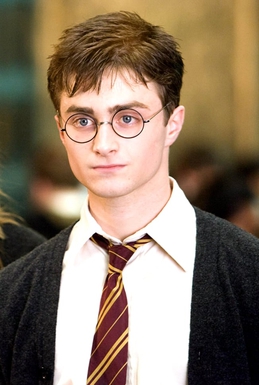
Harry James Potter is a fictional character and the titular protagonist in J. K. Rowling's series of eponymous novels. The majority of the books' plot covers seven years in the life of the orphan Harry, who, on his eleventh birthday, learns he is a wizard. Thus, he attends Hogwarts to practise magic under the guidance of the kindly headmaster Albus Dumbledore and other school professors along with his best friends Ron Weasley and Hermione Granger. Harry also discovers that he is already famous throughout the novel's magical community, and that his fate is tied with that of Lord Voldemort – the internationally feared Dark Wizard and murderer of his parents, James and Lily Potter. The book and film series revolve around Harry's struggle to adapt to the wizarding world and defeat Voldemort.
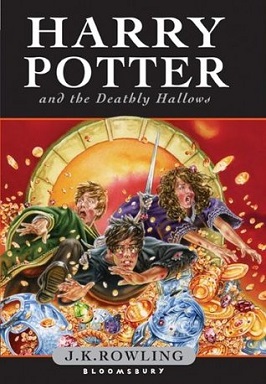
Harry Potter and the Deathly Hallows is a fantasy novel written by British author J. K. Rowling and the seventh and final novel in the Harry Potter series. It was released on 21 July 2007 in the United Kingdom by Bloomsbury Publishing, in the United States by Scholastic, and in Canada by Raincoast Books. The novel chronicles the events directly following Harry Potter and the Half-Blood Prince (2005) and the final confrontation between the wizards Harry Potter and Lord Voldemort.
The following is a list of magical objects used in the fictional universe of Harry Potter in the original book series, as well as in the adapted film series.
The following is a list of Hogwarts staff in the Harry Potter books written by J. K. Rowling.

Mary GrandPré is an American illustrator best known for her cover and chapter illustrations of the Harry Potter books in their U.S. editions published by Scholastic. She received a Caldecott Honor in 2015 for illustrating Barb Rosenstock's The Noisy Paint Box: The Colors and Sounds of Kandinsky's Abstract Art. GrandPré, who creates her artwork with paint and pastels, has illustrated more than twenty books and has appeared in gallery exhibitions and periodicals such as The New Yorker, Atlantic Monthly, and The Wall Street Journal.

Harry Potter is a series of seven fantasy novels written by British author J. K. Rowling. The novels chronicle the lives of a young wizard, Harry Potter, and his friends Hermione Granger and Ron Weasley, all of whom are students at Hogwarts School of Witchcraft and Wizardry. The main story arc concerns Harry's conflict with Lord Voldemort, a dark wizard who intends to become immortal, overthrow the wizard governing body known as the Ministry of Magic, and subjugate all wizards and Muggles.

The Leaky Cauldron, also called Leaky, TLC, or Leaky News, is a Harry Potter fansite and blog. The site features news, image and video galleries, downloadable widgets, a chat room and discussion forum, and an essay project called Scribbulus, among other offerings. Since 2005, the Leaky Cauldron has also hosted an official podcast, called PotterCast.

Evanna Patricia Lynch is an Irish actress and activist. She is best known for portraying Luna Lovegood in the Harry Potter film series.
Harry Potter is a series of fantasy novels by J. K. Rowling.

Rubeus Hagrid is a fictional character in the Harry Potter book series written by J. K. Rowling. He is introduced in Harry Potter and the Philosopher's Stone as a half-giant and half-human who is the gamekeeper and Keeper of Keys and Grounds of Hogwarts, the primary setting for the first six novels. In the third novel Harry Potter and the Prisoner of Azkaban, Hagrid is promoted to Care of Magical Creatures professor, and is later revealed to be a member of the Order of the Phoenix. A loyal, friendly, softhearted personality who is easily brought to tears, he is also known for his thick West Country accent.

Gili Bar-Hillel Semo is an English-Hebrew translator from Israel, best known for translating the Harry Potter series into Hebrew.

Ginevra Molly "Ginny" Weasley is a fictional character in J. K. Rowling's Harry Potter novel series. Ginny is introduced in the first book Harry Potter and the Philosopher's Stone, as the youngest sibling and only daughter of Arthur and Molly Weasley. She becomes Harry's main love interest and eventually marries him at the end of the series. She is portrayed by Bonnie Wright in all eight Harry Potter films.
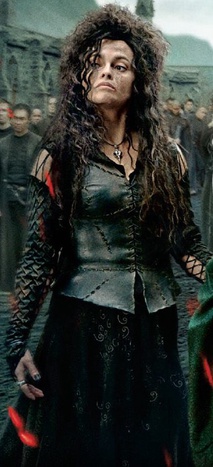
Bellatrix Lestrange (née Black) is a fictional character in the Harry Potter book series written by J. K. Rowling. She evolved from an unnamed peripheral character in Harry Potter and the Goblet of Fire into a major antagonist in subsequent novels. In the final installment of the story, Rowling established her as Lord Voldemort's "last, best lieutenant". Bellatrix was the first female Death Eater introduced in the books. Bellatrix had a fanatic obsession with the Dark Lord although she was clearly fearful of his magical abilities and absolute power over his forces. She is almost as sadistic and homicidal as Lord Voldemort, with a psychotic personality.
